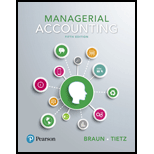
Ethical dilemmas (Learning Objective 4)
ETHICS
Maria Dees is the new controller for Harmony Tennis, a designer and manufacturer of tennis attire. Shortly before the December 31 fiscal year-end, Harmony Sapp (the company president) asks Dees how things look for the year-end numbers. Sapp is not happy to learn that earnings growth may be below 10% for the first time in the company’s five-year history. Sapp explains that financial analysts have again predicted a 12% earnings growth for the company and that she does not intend to disappoint them. She suggests that Dees talk to the assistant controller, who can explain how the previous controller dealt with this situation. The assistant controller suggests the following strategies:
- a. Postpone planned advertising expenditures from December to January.
- b. Do not record sales returns and allowances on the basis that they are individually immaterial.
- c. Persuade retail customers to accelerate January orders to December.
- d. Reduce the allowance for
bad debts (and bad debts expense). - e. Harmony Tennis ships finished goods to public warehouses across the country for temporary storage until it receives firm orders from customers. As Harmony Tennis receives orders, it directs the warehouse to ship the goods to nearby customers. The assistant controller suggests recording goods sent to the public warehouses as sales.
Requirements
Which of these suggested strategies are inconsistent with IMA standards? What should Dees do if Sapp insists that she follow all of these suggestions?
Want to see the full answer?
Check out a sample textbook solution
Chapter 1 Solutions
Managerial Accounting, Student Value Edition (5th Edition)
 Intermediate Financial Management (MindTap Course...FinanceISBN:9781337395083Author:Eugene F. Brigham, Phillip R. DavesPublisher:Cengage Learning
Intermediate Financial Management (MindTap Course...FinanceISBN:9781337395083Author:Eugene F. Brigham, Phillip R. DavesPublisher:Cengage Learning College Accounting (Book Only): A Career ApproachAccountingISBN:9781337280570Author:Scott, Cathy J.Publisher:South-Western College Pub
College Accounting (Book Only): A Career ApproachAccountingISBN:9781337280570Author:Scott, Cathy J.Publisher:South-Western College Pub Essentials of Business Analytics (MindTap Course ...StatisticsISBN:9781305627734Author:Jeffrey D. Camm, James J. Cochran, Michael J. Fry, Jeffrey W. Ohlmann, David R. AndersonPublisher:Cengage Learning
Essentials of Business Analytics (MindTap Course ...StatisticsISBN:9781305627734Author:Jeffrey D. Camm, James J. Cochran, Michael J. Fry, Jeffrey W. Ohlmann, David R. AndersonPublisher:Cengage Learning Pfin (with Mindtap, 1 Term Printed Access Card) (...FinanceISBN:9780357033609Author:Randall Billingsley, Lawrence J. Gitman, Michael D. JoehnkPublisher:Cengage Learning
Pfin (with Mindtap, 1 Term Printed Access Card) (...FinanceISBN:9780357033609Author:Randall Billingsley, Lawrence J. Gitman, Michael D. JoehnkPublisher:Cengage Learning College Accounting, Chapters 1-27AccountingISBN:9781337794756Author:HEINTZ, James A.Publisher:Cengage Learning,
College Accounting, Chapters 1-27AccountingISBN:9781337794756Author:HEINTZ, James A.Publisher:Cengage Learning, Cornerstones of Cost Management (Cornerstones Ser...AccountingISBN:9781305970663Author:Don R. Hansen, Maryanne M. MowenPublisher:Cengage Learning
Cornerstones of Cost Management (Cornerstones Ser...AccountingISBN:9781305970663Author:Don R. Hansen, Maryanne M. MowenPublisher:Cengage Learning





